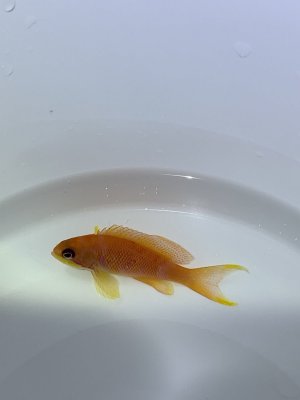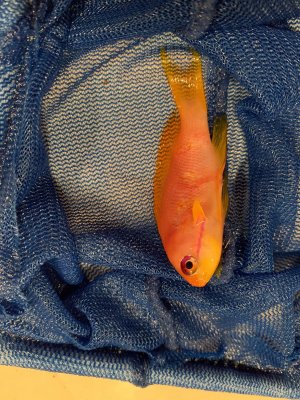- Joined
- Dec 19, 2019
- Messages
- 86
- Reaction score
- 85
First I would like to say that I quarantine and treat all of my fish, but I also understand that even that may not be foolproof. I have not introduced any new fish in months, and I do not even remember adding any new inverts or corals within last six months or so. So, I am very perplexed as to how this disease was introduced into my tank.
About two month ago one of my Anthias died. They have been in the tank for over six months without any sign of problems. Dead fish looked like it was missing some scales. At the time I was not sure if this was caused by crabs after the fish died (see first picture). Few days later I noticed similar sign on couple other Anthias. Few of my other tangs started showing signs of discomfort by scratching. I noticed few spots but was not sure if they were caused by scratching on rocks or a parasite. It did not look like ick. Scratching continued on and off for few weeks but eventually went away; and, after the initial week, I did not see any spots, just shaking and scratching. I decided that there was a chance they had flukes so I treated the tank with Poszipro twice, seven days apart. After the second treatment I notice one of the Anthias had stringy white poop (ie intestinal parasites). I did not start any treatment yet for this. At about the same time, I decided to do some maintenance and used power head to blow off the rocks which I have not done before. After this I noticed all of my Anthias disappeared for several days. One of the larger females came out fairy quickly and the male few days later. I could see two other females hiding in the rocks for another week or so. Now the two females came out of hiding but are just sitting on the sand bed and the remaining 3 females are nowhere to be seen and by now I assume they are dead. The two females that are sitting on the sand bed seem to have slightly lighter blotches, and are similar to earlier Anthias that died with what looked like missing scales. See second picture. The blotches are more noticeable under actinic lights so I will try to take another picture tonight.
Now I am not sure if missing Anthias and Anthias that are not swimming or eating is related to:
Any suggestion as to disease ID and recommended treatment would be appreciated. The Anthias that are not swimming have been like this for over two weeks, so I do not think they will live much longer unless that starts swimming and eating again.
I have one more very unlikely theory. Since I cannot figure out how this was introduced into my tank, I wonder if there are any parasites or viral infections that are spread though bird poop, or saltwater spray from the ocean, and can survive in fresh water. I use rain water to backwash my sand filter and I live in very close proximity to the ocean. After backwashing with rainwater, the sand filter is rinsed with saltwater, but I am sure some rainwater is not completely flushed out. Rainwater goes through sediment filter, carbon block, and UV light first. Theoretically, UV should kill any bacteria and parasites, but it is possible flow rate is too high and UV is not 100% effective. Does anyone who is fish disease expert know if it is possible to introduce disease with not properly treated rainwater? I figure this is very farfetched idea.


About two month ago one of my Anthias died. They have been in the tank for over six months without any sign of problems. Dead fish looked like it was missing some scales. At the time I was not sure if this was caused by crabs after the fish died (see first picture). Few days later I noticed similar sign on couple other Anthias. Few of my other tangs started showing signs of discomfort by scratching. I noticed few spots but was not sure if they were caused by scratching on rocks or a parasite. It did not look like ick. Scratching continued on and off for few weeks but eventually went away; and, after the initial week, I did not see any spots, just shaking and scratching. I decided that there was a chance they had flukes so I treated the tank with Poszipro twice, seven days apart. After the second treatment I notice one of the Anthias had stringy white poop (ie intestinal parasites). I did not start any treatment yet for this. At about the same time, I decided to do some maintenance and used power head to blow off the rocks which I have not done before. After this I noticed all of my Anthias disappeared for several days. One of the larger females came out fairy quickly and the male few days later. I could see two other females hiding in the rocks for another week or so. Now the two females came out of hiding but are just sitting on the sand bed and the remaining 3 females are nowhere to be seen and by now I assume they are dead. The two females that are sitting on the sand bed seem to have slightly lighter blotches, and are similar to earlier Anthias that died with what looked like missing scales. See second picture. The blotches are more noticeable under actinic lights so I will try to take another picture tonight.
Now I am not sure if missing Anthias and Anthias that are not swimming or eating is related to:
- Disease that killed the first Anthias or
- PoziPro treatment or
- Intestinal parasites or
- Stress from blowing off the rocks with the power head.
Any suggestion as to disease ID and recommended treatment would be appreciated. The Anthias that are not swimming have been like this for over two weeks, so I do not think they will live much longer unless that starts swimming and eating again.
I have one more very unlikely theory. Since I cannot figure out how this was introduced into my tank, I wonder if there are any parasites or viral infections that are spread though bird poop, or saltwater spray from the ocean, and can survive in fresh water. I use rain water to backwash my sand filter and I live in very close proximity to the ocean. After backwashing with rainwater, the sand filter is rinsed with saltwater, but I am sure some rainwater is not completely flushed out. Rainwater goes through sediment filter, carbon block, and UV light first. Theoretically, UV should kill any bacteria and parasites, but it is possible flow rate is too high and UV is not 100% effective. Does anyone who is fish disease expert know if it is possible to introduce disease with not properly treated rainwater? I figure this is very farfetched idea.




















